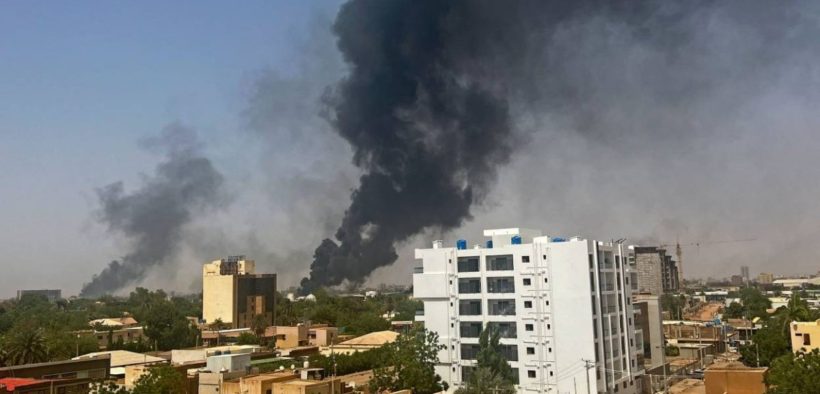Flames gripped the Sudan capital Central Khartoum

Flames gripped the Sudanese capital Khartoum on Sunday and paramilitary forces attacked the army headquarters for the second day in a row, witnesses reported, as fighting raged into its sixth month.
“Clashes are now happening around the army headquarters with various types of weapons,” witnesses told AFP on Sunday from Khartoum, while others reported fighting in the city of El-Obeid, 350 kilometres south.
Battles between the regular army and the paramilitary Rapid Support Forces (RSF) intensified on Saturday, resulting in several key buildings in central Khartoum being set alight.
In social media posts verified by AFP, users shared footage of flames devouring landmarks of the Khartoum skyline, including the Greater Nile Petroleum Oil Company Tower.A conical building with glass facades that had become an emblem of the city.
This morning a fire engulfed the Greater Nile Petroleum Operating Company Tower in Khartoum, a city where the army and the paramilitary Rapid Support Forces have been battling for 5 months. This highrise is about 1.5 km from the nearest army troops in territory controlled by RSF. pic.twitter.com/oJuAu0Xykt
— Sudan War Monitor (@sudanwarmonitor) September 17, 2023
Users mourned Khartoum, a shell of its former self, in posts that showed buildings — their windows blown out and their walls charred or pockmarked with bullets — continuing to smoulder.
Five minutes of eerie dystopian horror, this video gives a sniper’s view of the wasteland that was once the civic heart of Khartoum, the capital of a nation of 45 million people. It was filmed yesterday near the Goethe-Institut Sudan. For details: https://t.co/8ersBbsaeA pic.twitter.com/GFxkMeoVGO
— خواجة مسكين (@daniel_van0) September 17, 2023
Since from April 15
Since war erupted on April 15 between army chief Abdel Fattah al-Burhan and his former deputy, RSF commander Mohamed Hamdan Daglo, nearly 7,500 people have been killed, according to a conservative estimate from the Armed Conflict Location and Event Data Project.
It has displaced more than five million people, including 2.8m who have fled the relentless air strikes, artillery fire and street battles in Khartoum’s densely-populated neighbourhoods.
The millions that remain in the city woke up on Sunday to find clouds of smoke obscuring the skyline, as the sound of bombs and gunfire burst through the capital.
“We can hear huge bangs,” witnesses told AFP on Sunday from the Mayo district of southern Khartoum, where the army targeted RSF bases with artillery fire.
At least 51 people were killed last week in air strikes on a market in Mayo, according to the United Nations, in one of the deadliest single attacks of the war.
The worst of the violence has been concentrated in Khartoum and the western region of Darfur, where ethnically-motivated attacks by the RSF and allied militias have triggered renewed investigations by the International Criminal Court into possible war crimes.
There has also been fighting in the southern Kordofan region, where witnesses again reported on Sunday artillery fire exchanged between the army and the RSF in the city of El-Obeid.

I am a dedicated student currently in my seventh semester, pursuing a degree in International Relations. Alongside my academic pursuits, I am actively engaged in the professional field as a content writer at the Rangeinn website.








